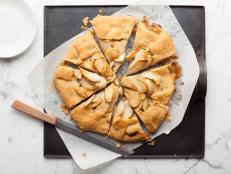How to Safely Cook for Others During the Pandemic
Whether you're cooking for your family or dropping off food at a neighbor's place, make sure you're as safe as possible with this advice from experts.

Westend61/Getty Images
Preparing stew for a neighbor, baking cookies for the local fire department, delivering a casserole to an elderly relative — sharing homemade food is one of the ways people have always supported each other through crises, and the current pandemic is no exception.
But is it safe? The last thing anyone sharing food wants to do is endanger the recipient.
Officially, according to the CDC, transmission of the coronavirus through food is not a big concern; person-to-person spread is the main issue. But that doesn’t mean we should be totally lax, either — especially since we may be preparing food to help out vulnerable people, like the elderly. Here are some precautions you can take to help you keep your friends, loved ones and others safe and well-fed.

Wavebreakmedia/Getty Images
Before You Start Cooking
Make sure you’re well. Along with fever, cough, shortness of breath and difficulty breathing, the CDC has added chills, repeated shaking with chills, headache, muscle pain, sore throat and loss of taste or smell to the list of COVID-19 symptoms to watch out for, notes Kristen Kelley, RN, director of infection prevention at Indiana University Health. If you have any of those symptoms, even mildly, it’s not a good idea to cook for others.
Even if you've had, and recovered from the virus, consult your doctor before cooking for others. Though there’s a lot of speculation in the news right now that people who have already had the virus may have immunity, caution is still necessary. "If someone has had COVID, and they want to cook for someone else, they should follow CDC guidelines for when to discontinue isolation, and wait for their doctor to clear them from COVID quarantine," Kelley says. So even if you’re feeling better, it isn’t safe for you to cook for others unless your doctor gives the green light.
Next, check that whomever you’re cooking for is comfortable receiving home-cooked food, notes Dr. Karen Krueger, MD, infectious disease specialist and instructor of medicine at Northwestern Medicine. Some people might only want items that can be reheated, while others are fine with baked goods or fresh produce. "Some people have different levels of comfort, even though we think the risk [of contracting the virus through food] is really low," she says.
Also, it’s important to be cognizant of any food allergies or other dietary restrictions, says food safety expert and trainer Jeff Nelken.
As you prepare, "Make sure your kitchen is clean and sanitized," says Martin Bucknavage, senior food safety extension associate at Penn State’s Department of Food Science. "Get rid of all the clutter in the kitchen that can make cleaning more difficult. And keep pets out of the kitchen before and during preparation, until the food is packaged," since we don’t yet know for sure the extent to which pets are a risk.
Sanitize your utensils, cutting boards and other equipment as much as possible, Nelken says, noting that running things through the dishwasher is a simple way to do that. Remember to run your sponge through the dishwasher frequently as well, he adds.

djedzura/Getty Images
While You're Cooking
It’s always crucial to follow standard food safety procedures, of course — so familiarize yourself with them if you haven’t in the past.
No doubt you already know to wash your hands thoroughly before you begin preparing food — but keep in mind that you may need to repeat the process while you’re cooking. "Especially if you end up touching your face or another surface or your phone during the cooking process, rewash your hands again before you're going to touch the food," Dr. Krueger says.
Another good practice to implement is to create clean and dirty areas of your kitchen, and keep them separate, Kelley says. Have your cleaned, sanitized utensils in the clean area, and then once you’ve used them, put them in another area for dirty items. Be sure to keep the clean containers that will store the food well within the clean area.
When packaging the food, use disposable containers or reusable ones that you don’t need back to minimize contact, Nelken says. If you want to be extra cautious, you can wrap the containers in plastic wrap or place them in a bag before transporting them, Kelley suggests. When the recipient gets the food, they can unwrap the containers or remove them from the bag before bringing them inside.

авторские/Getty Images
How to Deliver the Food
"This interaction probably represents the largest risk," Bucknavage says. "So the delivery person should be washing hands, wearing a mask, free of symptoms of illness, and maintaining physical distance."
The safest way to deliver the food is without any face-to-face interaction. One way to do that is to set up a time for delivery, and have the recipient instruct you where to leave the food — ideally on a raised surface like a table or chair, Nelken says. Knock, ring the doorbell or send a text to let the recipient know the food is there so they can receive it promptly, then either leave or back away to a safe distance — at least six feet — before they retrieve it.
"If you can drop the food off no-contact, that would be the best way to do it," Dr. Krueger says. "If you're going to cook for your neighbor, leave it outside their door and then just knock on their door and they can come pick it up 30 seconds later. The overall risk of transmitting the virus that way, especially if you're keeping social distancing with the handoff, is pretty low."
For your own safety, be sure to wash your hands thoroughly again when you get home, as you do any time you go out.
Related Links:

































